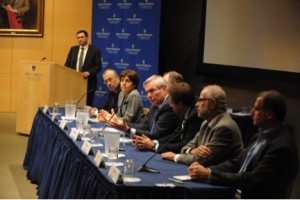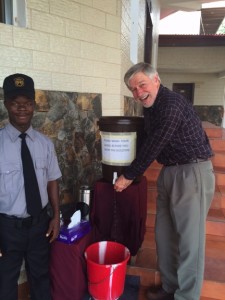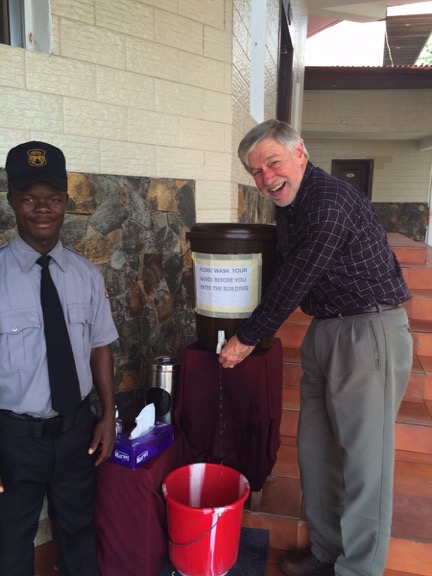On March 23, 2014, the World Health Organization confirmed an Ebola outbreak in Guinea. It was the first occurrence of the disease in West Africa and it involved the Zaire strain, the most deadly.
Although Ebola terrifies our popular imagination, outbreaks of the disease are relatively rare. Until 2014, approximately 2,400 people in Africa had been infected with the virus since it was first isolated in 1976.
According to Michael Osterholm, McKnight Presidential Endowed Chair in Public Health, Ebola had “hardly pinged the human species” before this recent epidemic.
Fifteen months after the outbreak was reported, more than 11,000 people have died of Ebola, including some 500 health care workers.
As the Ebola virus spread through Liberia, Guinea, and Sierra Leone in what Osterholm calls a “fireworks pattern” — sparks fly off that catch and flare — School of Public Health faculty and staff used their expertise to
help keep the epidemic from becoming a conflagration.
Spreading the Word

Osterholm is director of the University of Minnesota’s Center for Infectious Disease Research and Policy, or CIDRAP, one of the top sources in the world for breaking news on infectious diseases.
While at the Minnesota Department of Health in 1981, he was among the first to recognize HIV/AIDS as an epidemic.
As the late spring and summer of 2014 progressed, he saw Ebola’s shadow lengthening and a disaster taking shape for West Africa. In an effort to prevent this, Osterholm spoke anywhere and anytime.
He saw every engagement — “Just tell me where to go, and I’ll be there,” he told his colleagues — as an opportunity to convey the facts about the epidemic, its threats, and the vital role African health workers were playing. He warned against complacency.
In a July 29, 2014, opinion piece in the Washington Post, Osterholm urged faster, better coordinated, and smarter action from the global public health community and called for more resources and medical help on the ground.
“We are at a critical point, and the response by the international community and the affected countries will determine if this outbreak is just a chapter in the region’s story — or a dramatic and dangerous shift in West Africa’s future,” he wrote.
On August 8, WHO declared the epidemic “a public health emergency of international concern,” a move that would draw intense criticism six months later as being too little, too late.
Minnesota on the Ground
In August, when the number of Ebola cases was climbing steeply, Liberia’s minister for health and social welfare, Walter Gwenigale, wrote a letter to Sylvia Burwell, U.S. Secretary of Health and Human Services. Gwenigale asked if there was a way that the United States could work with his ministry on new approaches to treatment and prevention of Ebola. Burwell said yes and the two countries created PREVAIL (Partnership for Research on Ebola Virus in Liberia).
Burwell assigned Cliff Lane, NIH’s Deputy Director for Clinical Research and Special Projects, as the U.S. principal investigator for the collaboration.
Its first project was an Ebola vaccine trial called PREVAIL I based in Monrovia, Liberia. It would use two vaccines in a randomized, double-blind, placebo-controlled study to determine if a single dose of an experimental vaccine would protect against Ebola.
“I started to think about a team for this project and, of course, I’m going to go for a dream team,” says Lane.

the handwashing stations that were outside every public building during the Ebola epidemic. Photo courtesy of Jim Neaton
Lane wanted SPH’s Jim Neaton on that team. Neaton, a biostatistics professor, runs some of the largest HIV/AIDS treatment trials in the world and has a reputation for building strong, collaborative groups. Lane has worked with him for 20 years
“There’s nobody better than Jim at the science and operations of clinical research,” says Lane. “He brings those two things together in away that optimizes the chances for success. And that is what’s so incredibly special about him. And he has a phenomenal group at Minnesota.”
Neaton joined the team and knew he needed to get the vaccine trial up and running as soon as possible. He asked his long-time operations manager Gregg Larson to come out of retirement to set up logistics.
“I had a night to think about Jim’s offer, and two weeks later I was in Monrovia,” says Larson.
Finding Home Base
In Monrovia, Larson worked closely with NIH and the U.S. Embassy to find a place for the study headquarters. The location needed three critical assets: security, internet access, and reliable electricity — the vaccines had to be kept at -86 C. (nearly -123 F.) until thawed for use. Only the U.S. Embassy’s generators could provide uninterrupted power for the freezers, so Larson set about renovating space at the Embassy.
Next, he worked with NIH to determine suitable clinical sites. He jumped into the task as diplomat, fixer, problem-solver, and construction manager, running into intricate bureaucracy and political infighting along the way.
Monrovia once had the best teaching hospital in Africa, but poverty and two successive civil wars had compromised all health care facilities. Neaton, Larson, and NIH staff visited facilities with their Liberian colleagues and finally settled on Redemption Hospital, a
small institution in a part of Monrovia that was particularly hard hit by the epidemic. It was the best location to initiate vaccinations and establish a laboratory. Following that decision, NIH spent considerable funds renovating the space.
Study Underway
The trial began on February 2, 2015, with an initial plan of enrolling 600 participants. It was to be a Phase 2 trial to gather more data on the vaccines’ safety, immunogenicity — whether they will provoke an immune response — and ability to protect against Ebola. Phase 3 would be the next step.
The first step for trial participants was a clinic visit, where health care workers looked for specific symptoms and collected blood. Then they received one of the two vaccines or a placebo from a syringe whose label had first been scanned and the code matched
to the participant.
Every morning, two U.S. pharmacists and four Liberian pharmacists prepared the syringes. Each syringe got a coded label corresponding to the vaccine or placebo. They worked fast — the vaccines thawed in about 20 minutes, only held their potency in the syringes for 8 hours, and a driver had to travel about 40 minutes to Redemption to deliver the day’s supply.
The volunteers returned to the clinic after one week and after one month for an assessment of adverse effects and additional lab work.
Liberian and American trial personnel, with the essential aid of local community workers, continually monitored the participants.
“There are no house addresses in Monrovia, so we needed the help of people intimate with the neighborhoods,” says Neaton. “Community workers followed up with participants. They went to their homes to check on them, called them to see if they were feeling OK, and helped them get to the clinic for lab work. They were critical to our efforts.”
At the end of each day in Monrovia, all the collected data, which included lab results to assess if the vaccine was safe and produced an immune response, were transmitted to Minnesota.
Neaton’s team at the University immediately checked the information and entered it into databases the same day.
In a double-blind study — where neither the participant nor the researcher know who is receiving what treatment — someone has to be “unblinded.” If safety concerns arise, it’s crucial to be able to identify who received what drug or intervention. For this study, three of Neaton’s colleagues had that information: assistant professor Julian Wolfson, associate professor Birgit Grund, and research fellow Gregg Grandits.
“We crunched the data as it came in from Monrovia,” says Wolfson. “Our principal task was to produce two reports — one open and one closed — every two weeks.”
The open report went to Neaton and the protocol leadership and contained general information on the conduct of the study, but no data by treatment group. The 50-page-plus closed report went only to the Data and Safety Monitoring Board (DSMB), the watchdog group for the study. It included summary data by treatment group so the DSMB could ensure that the trial was on track, following protocol, and safe for study participants.
Teaming Up
As Neaton and his group were managing the vaccine trial, Osterholm and the CIDRAP team were hard at work at one of the things they do best — deliberating a sticky problem and arriving at something no one has done or seen before.
Osterholm realized that since 1976, the world had spent too little time and money developing Ebola vaccines and he was concerned that the disease could become a persistent, endemic threat. He wanted a roadmap to fast track Ebola vaccines that work.
“We needed to institutionalize an approach to anticipate Ebola outbreaks rather than just respond,” Osterholm says. “If you’re only responding, you’re too late.”
Osterholm contacted Jeremy Farrar, fellow infectious disease expert and director of the Wellcome Trust, a global charitable foundation second only to the Gates Foundation in money given for health support and health-related research.
Osterholm and Farrar called on 26 international leaders in public health, medicine, bioethics, humanitarian relief, and pharmaceutical manufacturing to establish a “Team B” — a set of fresh eyes that could envision a new, coordinated, and fast path to effective and safe Ebola vaccines.
“If we had been looking at Ebola four years ago with the creative imagination this group provides, think where we’d be now,” says Osterholm.
With great organizational support from CIDRAP, Team B released “Recommendations for Accelerating the Development of Ebola Vaccines” on February 17.
The comprehensive report covers funding, research development, vaccine efficacy, licensure, manufacturing, distribution, vaccine safety and administration, and ethics — all the critical issues that can be stumbling blocks in the way of an effective vaccine.
The report — the first of its kind not sponsored by the government —
also calls for putting African stakeholders in the forefront of decisions affecting the well being of their own people hit by an epidemic.
“Our Team B efforts represent the first time that an independent group of scientists have played such a key role in helping define the characteristics and develop a roadmap for a successful Ebola vaccine,” says Osterholm.
WHO has asked to use the Team B target product profile, which provides optimal criteria for Ebola vaccines in epidemic or endemic settings.
Changing Direction
The one certainty about this epidemic is that things will change unexpectedly. Neaton’s vaccine study did not go as planned, and for a good reason.
Incidences of Ebola in Liberia dropped drastically and the last person known to have Ebola in that country died on March 27, 2015 (as of June 1, 2015). Without an active spread of disease, there is no way to test the true effectiveness of a vaccine in a Phase 3 trial. The PREVAIL 1 study had to shift gears.
“When it became clear that it wouldn’t be feasible to do Phase 3 in Liberia, we continued enrolling in Phase 2 to gather as much information as we could,” says Wolfson. “We had pretty low enrollment of female volunteers, so we decided to increase the number of women and enroll beyond the original 600 volunteers to 1,500 total.”
Those volunteers will now be followed for 12 months with lab work including immune response tests at 6 and 12 months. This way, says Wolfson, “we can learn more about the durability of the vaccine. Will immunity be maintained or will it decline?”
Phase 3, which was intended to be a study of nearly 30,000 people, needs to find a new home in West Africa.
Using What’s There
With the infrastructure created in Monrovia for the vaccine trial, the U.S./Liberian partnership plans to conduct an observational study of those who survive Ebola.
“What’s clear is that there are a number of conditions that follow Ebola infection that are poorly understood and that probably are a significant cause of morbidity and perhaps even mortality in the survivors,” says Lane.
Neaton, again, will manage this study as well as a randomized control trial of the Ebola treatment drug, ZMapp.
Keeping an Eye Out
The current Ebola epidemic may be fading from West Africa, but as Osterholm says, the disease is now on the continent “in a new way.” Forty years ago, Ebola was confined to isolated rural villages where the likelihood of it spreading to the rest of the world was virtually zero. But with Africa’s burgeoning populations and the ease and frequency with which people travel within and among countries, the Ebola model has changed.
The quickly growing megacities of Africa have millions of people living in desperate conditions with no adequate health care services or public health infrastructure. When it comes to an Ebola epidemic, “These cities are open gas cans just waiting for someone to throw a match in,” says Osterholm.
New knowledge about Ebola transmission and containment, more trained medical and public health personnel, and greater education about the virus may create firewalls, but to truly protect a population and confine the disease, the world needs a quickly deployable Ebola vaccine.
“The thing that we all worry about is that this [epidemic] was the first shot across the bow,” says Osterholm.
“We may win battles against Ebola, but we will never win the war without an effective vaccine.”
How the Virus Spreads
Michael Osterholm, School of Public Health professor and infectious disease expert, has maintained that “the more we learn about Ebola, the more we realize we don’t know.”
It is well documented that Ebola can pass from person to person when bodily fluids — blood, urine, saliva, sweat, semen, feces, vomit, and breast milk — from an infected
person come into contact with the mucous membranes of a healthy person or enters his or her body through a break in the skin.
But in a 2015 paper, “Transmission of Ebola Viruses: What We Know and What We Do Not Know,” Osterholm and 15 international Ebola experts introduced for the first time the real possibility that the virus can be transmitted through the air.
“In all likelihood, this is already occurring in the patient setting,” says Osterholm, though it is hard to document. If a caregiver is close enough to an Ebola patient to be infected by minute airborne particles, the caregiver could also have been infected through more normal means. Careful scientific studies of Ebola transmission have been few.
Currently, no one believes that the Ebola virus is highly contagious as an airborne pathogen, but that could change as the virus evolves.
The paper concludes on a cautionary note: “The West Africa Ebola epidemic surprised even the most astute infectious disease experts in the global public health community; we should not assume that Ebola viruses are not capable of surprising us again at some point in the future.” –By Martha Coventry

